How Many Miles Is California From North To South

Map of California topography and geomorphic provinces

California's major mountain ranges
California is a U.Due south. state on the western declension of North America. Covering an surface area of 163,696 sq mi (423,970 kmtwo), California is amongst the about geographically various states. The Sierra Nevada, the fertile farmlands of the Central Valley, and the barren Mojave Desert of the southward are some of the major geographic features of this U.S. state. It is habitation to some of the globe'southward nearly exceptional trees: the tallest (coast redwood), well-nigh massive (Giant Sequoia), and oldest (bristlecone pine). It is also home to both the highest (Mountain Whitney) and lowest (Death Valley) points in the 48 face-to-face states. The state is by and large divided into Northern and Southern California, although the boundary between the two is non well defined. San Francisco is incomparably a Northern California city and Los Angeles likewise a Southern California one, but areas in between do non often share their conviction in geographic identity. The US Geological Survey defines the geographic eye of the state at a point near North Fork, California.[ tone ]
Globe scientists typically divide the state into eleven distinct geomorphic provinces with clearly divers boundaries. They are, from north to south, the Klamath Mountains, the Cascade Range, the Modoc Plateau, the Basin and Range, the Declension Ranges, the Central Valley, the Sierra Nevada, the Transverse Ranges, the Mojave Desert, the Peninsular Ranges, and the Colorado Desert.
State boundaries [edit]
The boundaries of California were defined by Spanish claims of Mexico, as part of the province of Alta California. The northern boundary of Spanish claims was set at 42 degrees latitude by the Adams–Onis Treaty of 1819.[1] The states of Nevada and Utah, also originally office of Alta California, too use that line for their northern boundaries. The southern boundary, between California and Mexico, was established by the Treaty of Guadalupe Hidalgo that ended the Mexican–American War in 1848. The line is nigh thirty miles n of the former Alta California southern boundary. The eastern boundary consists of ii straight lines: a north–south line from the northern border to the centre of Lake Tahoe, and a second line angling southeast to the Colorado River. From that point, 14 mi (23 km) due south-southwest of Davis Dam on Lake Mohave, the southeast boundary follows the Colorado River to the international border west of Yuma. The eastern and south-eastern boundaries were decided upon during the debates of the California Ramble Convention in 1849.
Northern California [edit]
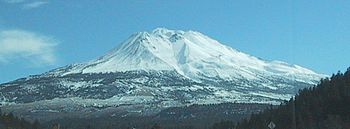
Northern California usually refers to the state's northernmost 48 counties.
The main population centers of Northern California include San Francisco Bay Area (which includes the cities of San Francisco, Oakland, and the largest metropolis of the region, San Jose), and Sacramento (the state capital) every bit well equally its metropolitan area. It also contains redwood forests, along with the Sierra Nevada including Yosemite Valley and Lake Tahoe, Mount Shasta (the 2nd-highest acme in the Cascade Range after Mount Rainier in Washington), and the northern half of the Central Valley, 1 of the world'south near productive agricultural regions. The climate can be by and large characterized by its marine to warm Mediterranean climates along the coast, to somewhat Continental Mediterranean Climate in the valley to alpine climate zones in the high mountains. Autonomously from the San Francisco Bay Surface area and Sacramento metropolitan areas (and some other cities in the Primal Valley), it is a region of relatively low population density. Northern California's economy is noted for being the de facto world leader in industries such as loftier technology (both software and semiconductor), as well as being known for clean power, biomedical, government, and finance.
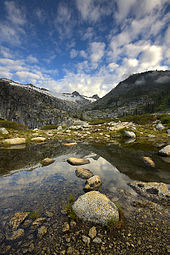
Klamath Mountains [edit]
The Klamath Mountains are a range in northwest California and southwest Oregon, the highest peak existence Mount Eddy in Trinity Canton, California, at 9,037 anxiety (two,754 m).[2] The range has a varied geology, with substantial areas of serpentine and marble. The climate is characterized by moderately common cold winters with heavy snow and warm, very dry summers with express rainfall.[iii] Every bit a consequence of the geology, the mountains have a unique flora, including several owned or near-endemic species, such as Lawson's Cypress (Chamaecyparis lawsoniana) and Foxtail Pino (Pinus balfouriana). Brewer's Spruce (Picea breweriana) and Kalmiopsis (Kalmiopsis leachiana) are relict species, remaining since the last ice age.[4]
Pour Range [edit]
The Pour Range is a mountainous region stretching from the Fraser River in British Columbia, Canada down to south of Lassen Peak, California.[5] The Cascades (equally they are called for curt) are part of the Pacific Ring of Burn down, the ring of volcanoes effectually the Pacific Body of water.[half dozen] All of the known historic eruptions in the face-to-face U.s.a. have been from either Cascade volcanoes or almost Mono Lake.[vii] : 7 Lassen Peak was the terminal Cascade volcano to erupt in California, from 1914 to 1921. Lassen is the about southerly active volcano of the Cascade chain.[8]
This region is located in the northeastern section of the state bordering Oregon and Nevada, mostly northward of the Central Valley and the Sierra Nevada mountain range. The surface area is centered on Mountain Shasta, near the Trinity Alps. Mount Shasta is a dormant volcano, merely there is some prove that information technology erupted in the 18th Century.[seven] : 99
Modoc Plateau [edit]
In the northeast corner of the state lies the Modoc Plateau, an area of lava flows that formed a 1000000 years ago and now prevarication at an altitude of 4,000 to 5,000 anxiety (i,200 to 1,500 m).[9] The plateau has many cinder cones, juniper flats, pino forests, and seasonal lakes.[x] The plateau lies between the Cascade Range to the west and the Warner Mountains to the eastward.[nine] The Lost River watershed drains the north part of the plateau, while southern watersheds either collect in basin reservoirs or flow into Big Sage Reservoir and thence to the Pit River.
9 percent of the plateau is protected as reserves or wilderness areas,[9] such every bit the Modoc National Wildlife Refuge.[11] The plateau supports large herds of mule deer (Odocoileus hemionus), Rocky Mountain Elk (Cervus canadensis), and pronghorn (Antilocapra americana).[9] Herds of wild horses and livestock grazing have altered the original high desert ecosystem of the plateau.[9]

Basin and Range [edit]
To the east of the Sierra is the Bowl and Range geological province, which extends into Nevada. The Basin and Range is a series of mountains and valleys (specifically horsts and grabens), acquired by the extension of the World's crust.[12] One notable characteristic of the Bowl and Range is Mono Lake, which is the oldest lake in N America.[13] The Basin and Range also contains the Owens Valley, the deepest valley in North America (more than x,000 anxiety (3 km) deep, equally measured from the top of Mount Whitney).[fourteen]
In the eastern part of the state, below the Sierra Nevada, there is a serial of dry lake beds that were filled with h2o during the last water ice historic period (fed by ice melt from alpine glaciers only never directly affected by glaciation; see pluvial).[15] Many of these lakes have extensive evaporite deposits that contain a variety of dissimilar salts. In fact, the salt sediments of many of these lake beds have been mined for many years for various salts, most notably borax (this is about famously true for Owens Lake and Death Valley).
In this province reside the White Mountains, which are abode to the oldest living organism in the world, the bristlecone pino[16]
Coast Ranges [edit]
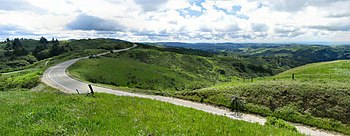
Skyline Boulevard, along the crest of the Santa Cruz Mountains
To the west of the Central Valley lies the Coast Ranges, including the Diablo Range, just eastward of San Francisco, and the Santa Cruz Mountains, to the southward of San Francisco. The Coast Ranges northward of San Francisco get increasingly foggy and rainy. These mountains are noted for their coast redwoods, the tallest trees on earth, which live within the range of the coastal fog.
Central Valley [edit]
California's geography is largely divers by its primal feature—the Central Valley, a huge, fertile valley betwixt the littoral mountain ranges and the Sierra Nevada. The northern function of the Central Valley is called the Sacramento Valley, later on its main river, and the southern role is called the San Joaquin Valley , afterwards its main river. The whole Key Valley is watered by mount-fed rivers (notably the San Joaquin, Kings, and Sacramento) that drain to the San Francisco Bay system. The rivers are sufficiently large and deep that several inland cities, notably Stockton, and Sacramento are seaports.
The southern tip of the valley has interior drainage and thus is not technically part of the valley at all. Tulare Lake, once 570 square miles (1,476 square kilometers) and now dry and covered with agricultural fields, one time filled much of the expanse.
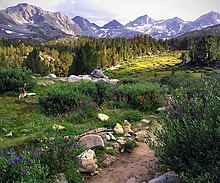
Sierra Nevada [edit]
In the e of the country lies the Sierra Nevada, which runs due north-south for 400 miles (640 km). The highest top in the contiguous United States, Mount Whitney at 14,505 feet (4.42 km), lies within the Sierra Nevada. The topography of the Sierra is shaped past uplift and glacial activity.
The Sierra has 200–250 sunny days each year, warm summers, fierce winters, and varied terrain, a rare combination of rugged variety and pleasant weather. The famous Yosemite Valley lies in the Key Sierra. The big, deep freshwater Lake Tahoe lies to the North of Yosemite. The Sierra is too dwelling house to the Giant Sequoia, the most massive trees on Globe.
The nearly famous hiking and horse-packing trail in the Sierra is the John Muir Trail, which goes from the acme of Mt. Whitney to Yosemite valley. This is role of the Pacific Crest Trail that goes from Mexico to Canada. The three major national parks in this province are Yosemite National Park, Kings Coulee National Park, and Sequoia National Park.
Southern California [edit]

The term Southern California normally refers to the 10 southernmost counties which closely match the lower one-third of California's span of latitude. This definition coincides neatly with the county lines at 35° 47′ 28″ north breadth, which form the northern borders of San Luis Obispo, Kern, and San Bernardino counties. Another definition for Southern California uses the Tehachapi Mountains every bit geographic landmarks for the northern boundary.
Southern California consists of a heavily developed urban surround, home to some of the largest urban areas in the state, along with vast areas that have been left undeveloped. With over 22 one thousand thousand people, roughly 60% of California's population resides in Southern California. It is the second-largest urbanized region in the United States, second just to the Washington/Philadelphia/New York/Boston Northeastern Megalopolis. Where these cities are dense, with major downtown populations and significant runway and transit systems, much of Southern California is famous for its large, spread-out, suburban communities and use of automobiles and highways. The dominant areas are Los Angeles, Orange County, San Diego, and Riverside-San Bernardino, each of which is the center of its respective metropolitan surface area, composed of numerous smaller cities and communities. The urban area is also host to an international metropolitan region in the form of San Diego–Tijuana, created past the urban area spilling over into Baja California.
Southern California is noted for industries including the picture industry, residential construction, entertainment industry, and military machine aerospace. Other industries include software, automotive, ports, finance, tourism, biomedical, and regional logistics.
Transverse Ranges [edit]
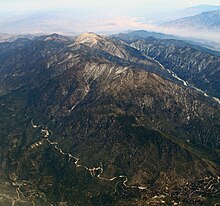
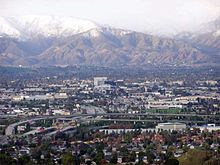
Southern California is separated from the rest of the state by the east–west trending Transverse Ranges, including the Tehachapi, which dissever the Central Valley from the Mojave Desert. Urban Southern California intersperses the valleys between the Santa Susana Mountains, Santa Monica Mountains and San Gabriel Mountains, which range from the Pacific Coast, eastward over 100 miles (160 km), to the San Bernardino Mountains, north of San Bernardino. The highest betoken of the range is Mount San Gorgonio at 11,499 anxiety (three,505 grand). The San Gabriel Mountains take Mountain Wilson observatory, where the redshift was discovered in the 1920s.
The Transverse Ranges include a series of e–w trending mountain ranges that extend from Indicate Conception at the western tip of Santa Barbara County, eastward (and a bit south) to the e cease of the San Jacinto Mountains in western Riverside County. The Santa Ynez Mountains make upward the westernmost ranges, extending from Point Formulation to the Ventura River simply westward-northwest of Ojai, in Ventura County. Pino Mountain Ridge, Nordhoff Ridge–Topatopa Mountains, Rincon Peak–Red Mountain, Sulphur Mountain, Santa Paula Ridge, South Mountain–Oat Mountain–Santa Susana Mountains, Simi Hills, Conejo Mountains–Santa Monica Mountains are all part of the Western Transverse Ranges, in Ventura and western Los Angeles counties.
The Liebre Mountains occupy the northwest corner of Los Angeles County, and represent a northwestern extension of the San Gabriel Mountains, both on the Pacific Plate side of the San Andreas Fault. The fault divides the San Gabriel Mountains from the San Bernardino Mountains further to the east in San Bernardino County.
It is possible to surf in the Pacific Ocean and ski on a mount during the same wintertime solar day in Southern California.
Mojave Desert [edit]
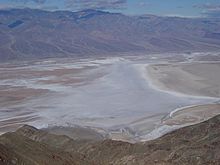
Badwater Bowl: the lowest point in North America at −279 feet (−85 m).
There are harsh deserts in the Southeast of California. These deserts are caused by a combination of the cold offshore current, which limits evaporation, and the rain shadow of the mountains. The prevailing winds blow from the ocean inland. When the air passes over the mountains, adiabatic cooling causes nearly water in the air to rain on the mountains. When the air returns to sea level on the other side of the mountains, information technology recompresses, warms and dries, parching the deserts. When the wind blows from inland, the resulting hot dry katabatic winds are called the Santa Ana Winds.
The Mojave Desert is bounded by the peninsular Tehachapi Mountains on the Northwest, together with the San Gabriel and the San Bernardino Mountains on the Southwest. These Western boundaries are quite singled-out, forming the dominant pie-slice shaped Antelope Valley in Southern California. The outlines of this valley are caused by the two largest faults in California: the San Andreas and the Garlock. The Mojave Desert extends Due east into the Country of Nevada. The Mojave Desert receives less than 6 inches (150 mm) of rain a twelvemonth and is by and large between 3,000 and 6,000 feet (1,000 and 2,000 m) of elevation. Areas such equally the Antelope Valley desert which is a high desert received snow each year, in the past it could snow two–3 times a twelvemonth; however, recently snow level has declined significantly to one time a twelvemonth or less. Most of the towns and cities in the California portion of the Mojave are relatively small, except for Palmdale and Lancaster. Even so, some are quite famous like Barstow, a popular end on the famous U.S. Road 66. The Mojave Desert also contains the everyman, hottest place in the Americas: Decease Valley, where temperature normally approaches 120 °F (49 °C), in late July and early Baronial.
Peninsular Ranges [edit]
The southernmost mountains of California are the Peninsular Ranges, which are east of San Diego and continue into Baja California (Mexico) in the Sierra San Pedro Martir. The Peninsular Ranges incorporate the Laguna Mountains, the San Jacinto Mountains, the Santa Rosa Mountains, the Santa Ana Mountains and the Palomar Mountain Range, notable for its famous Palomar observatory. San Jacinto Top'due south eastern shoulder has a cablevision tram that runs from the desert floor to nearly the top of the mountain where riders tin can fix off hiking or go cantankerous-country skiing.
Colorado Desert [edit]

The Coachella Valley Preserve
To the east of the peninsular ranges lie the Colorado and Sonoran Deserts, which extend into Arizona and Mexico.
The ground tiptop is by and large lower and in some areas was compressed downward, therefore the eastern Coachella and Imperial Valleys due north of the U.Due south.-Mexican border are below bounding main level, the lowest community in the U.S. is Calipatria, California, at 180 anxiety (55 m) below sea level.[17]
One feature of the desert is the Salton Sea, an inland lake that was formed in 1905 when a swollen Colorado River breached a canal nearly the U.S.-Mexico border and flowed into the Salton Sink (Salton Basin) for almost two years. Today, the Salton Body of water, a new version of historic Lake Cahuilla, remains equally California's largest lake.
Pacific Bounding main [edit]
The Pacific Ocean lies to the west of California. Owing to the long length of the country, Sea temperatures generally range from 50 °F (10 °C) in the northernmost parts during wintertime to seventy °F (21 °C) in the southward declension during summer. The lower seasonal temperature variance compared to the waters of the Eastward Coast is because of up-welling deep waters with dissolved nutrients. Therefore, sea life in and around California has examples of both Arctic and tropical, biotopes, leaning more towards the latter in the due south coast and vice versa. The sea off California is remarkably fertile, a murky green filled with a massive multifariousness of fish, rather than the clear dead bluish of most tropical seas. Before 1930, there was an extremely valuable sardine (herring) fishery off Monterey, only this was depleted, an event subsequently famous equally the background to John Steinbeck'due south Cannery Row.
California's coastline is almost 840 miles long, the third longest coastline in the United States subsequently Alaska and Florida.
Geology [edit]
Faults, volcanoes, and tsunamis [edit]
Earthquakes occur due to faults that run the length of the Pacific coast, the largest being the San Andreas Error. Major historical earthquakes include, with the magnitudes listed:
- 1906 San Francisco earthquake (magnitude 7.8–eight.2)
- 1971 San Fernando convulsion (magnitude 6.half-dozen)
- 1989 Loma Prieta earthquake (magnitude six.9–vii.one)
- 1994 Northridge earthquake (magnitude half-dozen.7)
Coastal cities are vulnerable to tsunamis from locally generated earthquakes equally well equally those elsewhere in the Pacific Ring of Fire. The Great Chilean earthquake tsunami (1960) killed 1 person and acquired $500,000 to $1,000,000 dollars of damage in Los Angeles, damaged harbors in many coastal cities, and flooded streets in Crescent City.[18] Waves from the Alaskan Skillful Fri convulsion of 1964 killed twelve people in Crescent Urban center and caused impairment as far south as Los Angeles. USGS has released the UCERF California earthquake forecast which models earthquake occurrence in California.
California is also home to several volcanoes, including Lassen Peak, which erupted in 1914 and 1921, and Mountain Shasta.
Tectonics [edit]
California, when only partially explored by the Castilian, was once thought to be an isle, every bit when the southern Baja California Peninsula is approached from the Gulf of California the state appears to the west. It is expected, through the motions of plate tectonics that the bounding main flooring spreading now acting in the Gulf of California (also known as the Bounding main of Cortez) will eventually extend through Southern California and forth the San Andreas fault to beneath San Francisco, finally forming a long island in less than 150 million years. (For comparison, this is too the gauge age of the Atlantic Ocean.) Predictions propose that this isle will somewhen collide with Alaska later an additional 100 million years.

California map of Köppen climate classification.
Climate [edit]
California's climate varies widely, from arid to subarctic, depending on breadth, elevation, and proximity to the coast. Littoral and Southern parts of the state have a Subtropical Mediterranean climate, with somewhat rainy winters and dry summers. The influence of the ocean generally moderates temperature extremes, creating warmer winters and substantially cooler summers, especially forth the coastal areas.
The state is field of study to coastal storms during the winter. Eastern California is subject to summertime thunderstorms acquired by the Due north American monsoon. Dry out weather during the rest of the year produces conditions favorable to wildfires. California hurricanes occur less ofttimes than their counterparts on the Atlantic Ocean. Higher elevations experience snowstorms in the winter months.
Floods are occasionally acquired by heavy pelting, storms, and snowmelt. Steep slopes and unstable soil make certain locations vulnerable to landslides in wet weather condition or during earthquakes.
See as well [edit]
- Deserts of California
- Ecology of California
- Listing of California 14,000-pes summits
- Listing of California state parks
- List of forts in California
- List of lakes in California
- List of mountain peaks of California
- Listing of mountain ranges of California
- List of regions of California
- List of rivers of California
- Listing of the major 3000-meter summits of California
- List of islands of California
- Listing of lakes of California
- List of beaches in California
References [edit]
- ^ Barnard, Jeff (May 19, 1985). "California–Oregon Dispute : Border Fight Has Townfolk on Border". Los Angeles Times.
- ^ "Klamath Mountains". Peakbagger . Retrieved 2015-12-16 .
- ^ Skinner, C.N.; Taylor, A.H.; Agee, J.K. (2006). "Klamath Mountains bioregion". In Sugihara, North.Yard.; van Wagtendonk, J.W.; Fites-Kaufman, J.; Shaffer, Yard.E.; Thode, A.E. (eds.). Fire in California's Ecosystems. Berkeley, CA: University of California Press. pp. 170–194.
- ^ "KLAMATH-SISKIYOU REGION, California and Oregon, U.S.A." North America Regional Centre of Endemism. Smithsonian Institution. Archived from the original on 2011-06-06. Retrieved 2011-11-26 .
- ^ Beckey, Fred W. (2000). Cascade Tall Guide: Columbia River to Stevens Pass. Mountaineers Press. p. eleven.
- ^ Singh, Pratap; Haritashya, Umesh Kumar (2011). Encyclopedia of Snowfall, Ice and Glaciers. Springer. p. 111.
- ^ a b Harris, Stephen L. (2005). Fire Mountains of the Due west: The Cascade and Mono Lake Volcanoes (3rd ed.). Mountain Press Publishing Visitor. ISBN978-0-87842-220-3.
- ^ "Eruptions of Lassen Peak". USGS. Fact Sail 173-98. Retrieved 2011-11-26 .
- ^ a b c d e "Modoc Plateau Region" (PDF). California Wild fauna Activity Plan. California Section of Fish and Game. 2007. Archived from the original (PDF) on 2009-05-02.
- ^ Sugihara, Neil G. (2006). Fire in California'southward ecosystems. University of California Press. p. 225.
- ^ "Modoc National Wildlife Refuge". US Fish and Wildlife Service.
- ^ "Basin and Range Province". USGS Geology in the Parks. USGS. Archived from the original on 2009-01-25. Retrieved 2012-01-15 .
- ^ Harris, S.Fifty. (2005). Fire Mountains of the West: The Cascade and Mono Lake Volcanoes. Mountain Press. p. 61. ISBN978-0-87842-511-2.
- ^ Smith, Genny; Putnam, Jeff (1976). Deepest Valley: a Guide to Owens Valley, its roadsides and mountain trails (2nd ed.). Genny Smith books. ISBN0-931378-14-one.
- ^ United states of america Geological Survey (xxx June 2000). "Shoreline Butte: Water ice age Decease Valley". Decease Valley Geology Field Trip Shoreline Butte. Department of the Interior. Retrieved 2009-09-10 .
- ^ Bain, G. Donald (2001). "Explore the Methuselah Grove". NOVA Online: Methuselah Tree. PBS.
- ^ "Geographic Names Information System".
- ^ May 22, 1960 Tsunami
External links [edit]
- Map of Northern California
- Map of Southern California
Coordinates: 37°ix′58″Northward 119°26′58″W / 37.16611°N 119.44944°W / 37.16611; -119.44944 (Center of California)
- CA State Geoportal
Source: https://en.wikipedia.org/wiki/Geography_of_California

0 Response to "How Many Miles Is California From North To South"
Post a Comment